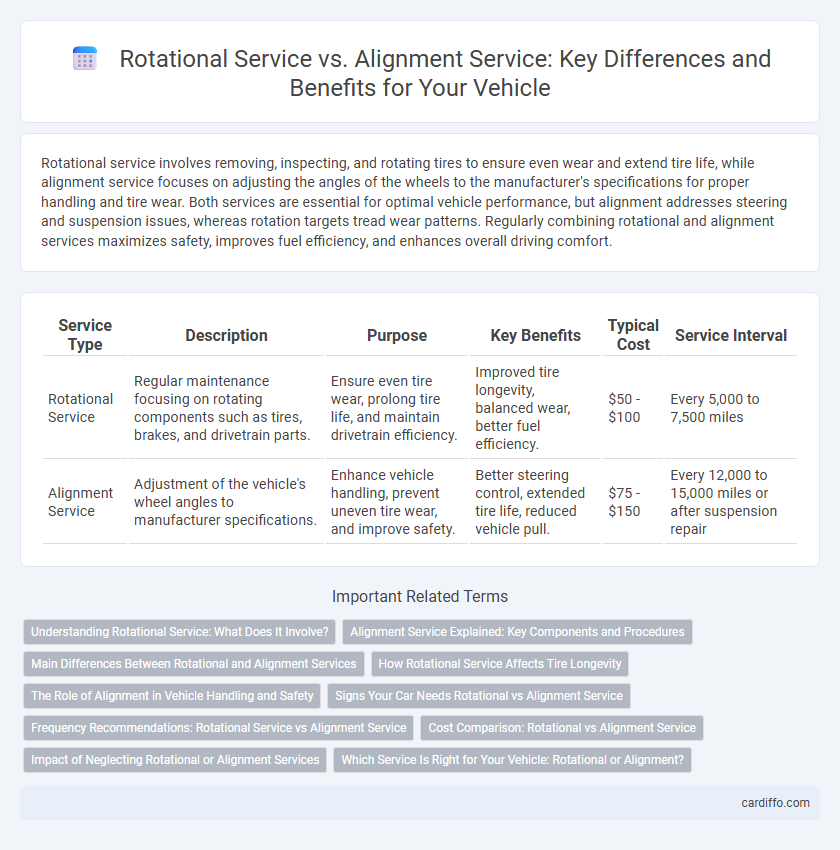Rotational service involves removing, inspecting, and rotating tires to ensure even wear and extend tire life, while alignment service focuses on adjusting the angles of the wheels to the manufacturer's specifications for proper handling and tire wear. Both services are essential for optimal vehicle performance, but alignment addresses steering and suspension issues, whereas rotation targets tread wear patterns. Regularly combining rotational and alignment services maximizes safety, improves fuel efficiency, and enhances overall driving comfort.
Table of Comparison
| Service Type | Description | Purpose | Key Benefits | Typical Cost | Service Interval |
|---|---|---|---|---|---|
| Rotational Service | Regular maintenance focusing on rotating components such as tires, brakes, and drivetrain parts. | Ensure even tire wear, prolong tire life, and maintain drivetrain efficiency. | Improved tire longevity, balanced wear, better fuel efficiency. | $50 - $100 | Every 5,000 to 7,500 miles |
| Alignment Service | Adjustment of the vehicle's wheel angles to manufacturer specifications. | Enhance vehicle handling, prevent uneven tire wear, and improve safety. | Better steering control, extended tire life, reduced vehicle pull. | $75 - $150 | Every 12,000 to 15,000 miles or after suspension repair |
Understanding Rotational Service: What Does It Involve?
Rotational service primarily involves the systematic detachment, inspection, and rotation of tires to ensure even tread wear and extend tire lifespan. This process includes checking tire pressure, tread depth, and balancing to maintain optimal vehicle performance and safety. Understanding rotational service helps prevent premature tire replacement and enhances fuel efficiency by promoting uniform tire wear across all wheels.
Alignment Service Explained: Key Components and Procedures
Alignment service involves adjusting a vehicle's suspension angles -- camber, caster, and toe -- to ensure tires meet the road at optimal angles for even wear and stable handling. Precision measurements are taken using alignment machines, and adjustments are made to restore manufacturer specifications, enhancing tire life and improving fuel efficiency. Unlike rotational service, which swaps tires to balance wear, alignment service corrects underlying suspension issues to prevent uneven tire degradation and steering problems.
Main Differences Between Rotational and Alignment Services
Rotational service involves regularly changing tire positions to ensure even tread wear and extend tire lifespan, while alignment service focuses on adjusting the angles of the wheels to optimize vehicle handling and prevent uneven tire wear. Rotations are typically recommended every 5,000 to 8,000 miles, whereas alignments are suggested when experiencing steering issues or after suspension repairs. Proper execution of both services enhances driving safety, improves fuel efficiency, and maximizes tire performance.
How Rotational Service Affects Tire Longevity
Rotational service significantly enhances tire longevity by evenly distributing wear across all tires, preventing uneven tread degradation. Regular tire rotations help maintain balanced handling and traction, reducing the risk of premature tire replacement due to localized wear. Compared to alignment service, which corrects wheel angles for optimal contact, rotational service directly extends tire life by managing tread wear patterns effectively.
The Role of Alignment in Vehicle Handling and Safety
Alignment service adjusts the angles of the wheels to the manufacturer's specifications, ensuring proper vehicle handling and stability, which directly impacts safety by improving traction and reducing tire wear. Rotational service involves changing the position of tires to balance tire wear and extend tire life but does not address wheel geometry. Proper alignment maintains optimal steering response and vehicle control, preventing uneven tire wear and potential safety hazards on the road.
Signs Your Car Needs Rotational vs Alignment Service
Uneven tire wear and vehicle pulling to one side are key signs your car needs alignment service, while vibrations in the steering wheel and irregular tire tread patterns indicate a rotational service is necessary. Alignment service corrects the angles of the wheels to the manufacturer's specifications, improving handling and extending tire life. Rotational service involves changing tire positions to ensure even wear, enhancing overall tire performance and safety.
Frequency Recommendations: Rotational Service vs Alignment Service
Rotational service is generally recommended every 5,000 to 7,500 miles to maintain even tire wear and extend tire lifespan, while alignment service is advised annually or when uneven tire wear, steering pull, or vibration occurs. Frequent rotational service helps balance tire wear across all wheels, whereas alignment ensures the wheels are correctly angled to optimize vehicle handling and tire performance. Following these frequency recommendations prevents premature tire replacement and enhances overall driving safety.
Cost Comparison: Rotational vs Alignment Service
Rotational service typically costs less than alignment service due to its simpler process of evenly distributing tire wear by rotating tires to different positions. Alignment service involves precise calibration of suspension angles, which requires specialized equipment and more labor, resulting in higher costs. Choosing rotational service can extend tire life affordably, while alignment service ensures optimal handling and tire performance at a comparatively higher price.
Impact of Neglecting Rotational or Alignment Services
Neglecting rotational service can lead to uneven tire wear, reduced fuel efficiency, and compromised vehicle handling, increasing the risk of accidents. Ignoring alignment service causes improper tire positioning, resulting in steering difficulties, accelerated tire damage, and potential suspension system strain. Regular maintenance of both rotational and alignment services is essential to ensure optimal tire performance, safety, and prolong vehicle lifespan.
Which Service Is Right for Your Vehicle: Rotational or Alignment?
Rotational service involves systematically moving tires to different positions on the vehicle to promote even tire wear and extend tire life, typically recommended every 5,000 to 7,500 miles. Alignment service adjusts the angles of the wheels to the manufacturer's specifications, ensuring the vehicle drives straight, improves handling, and prevents uneven tire wear. Choosing between rotational and alignment service depends on your vehicle's tire wear patterns and driving behavior, with rotations suited for routine maintenance and alignments necessary after hitting curbs, potholes, or when experiencing steering issues.
Rotational service vs Alignment service Infographic

 cardiffo.com
cardiffo.com